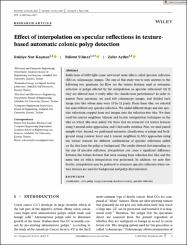Effect of interpolation on specular reflections in texture-based automatic colonic polyp detection
Özet
Reflections of LED light cause unwanted noise effects called specular reflection (SR) on colonoscopic images. The aim of this study was to seek answers to the following two questions. (a) How are the texture features used in automatic detection of polyps affected by the interpolation on specular reflections? (b) If they are affected does it really affect the classification performance? In order to answer these questions, we used 610 colonoscopy images, and divided each image into tiles whose sizes were 32-by-32 pixels. From these tiles, we selected the ones without any specular reflection. We added different shape and size specular reflections cropped from real images onto the reflection-free tiles. We then used the nearest neighbors, bilinear and bicubic interpolation techniques on the tiles on which SRs were added. On these tiles we extracted 116 texture features using 3 second-order approaches, and 4 first-order statistics. First, we used paired samplettest. Second, we performed automatic classification of polyps and background using random forest and k nearest neighbors (k-NN) approaches using the texture features for different combinations of specular reflections added on the tiles from the polyp or background. The results showed that depending on the size of specular reflection, interpolation can cause a significant difference between the texture features that were coming from reflection-free tiles and the same tiles on which interpolation was performed. In addition, we note that bicubic interpolation may be preferred to eliminate specular reflection when texture features are used for background and polyp discrimination.


















